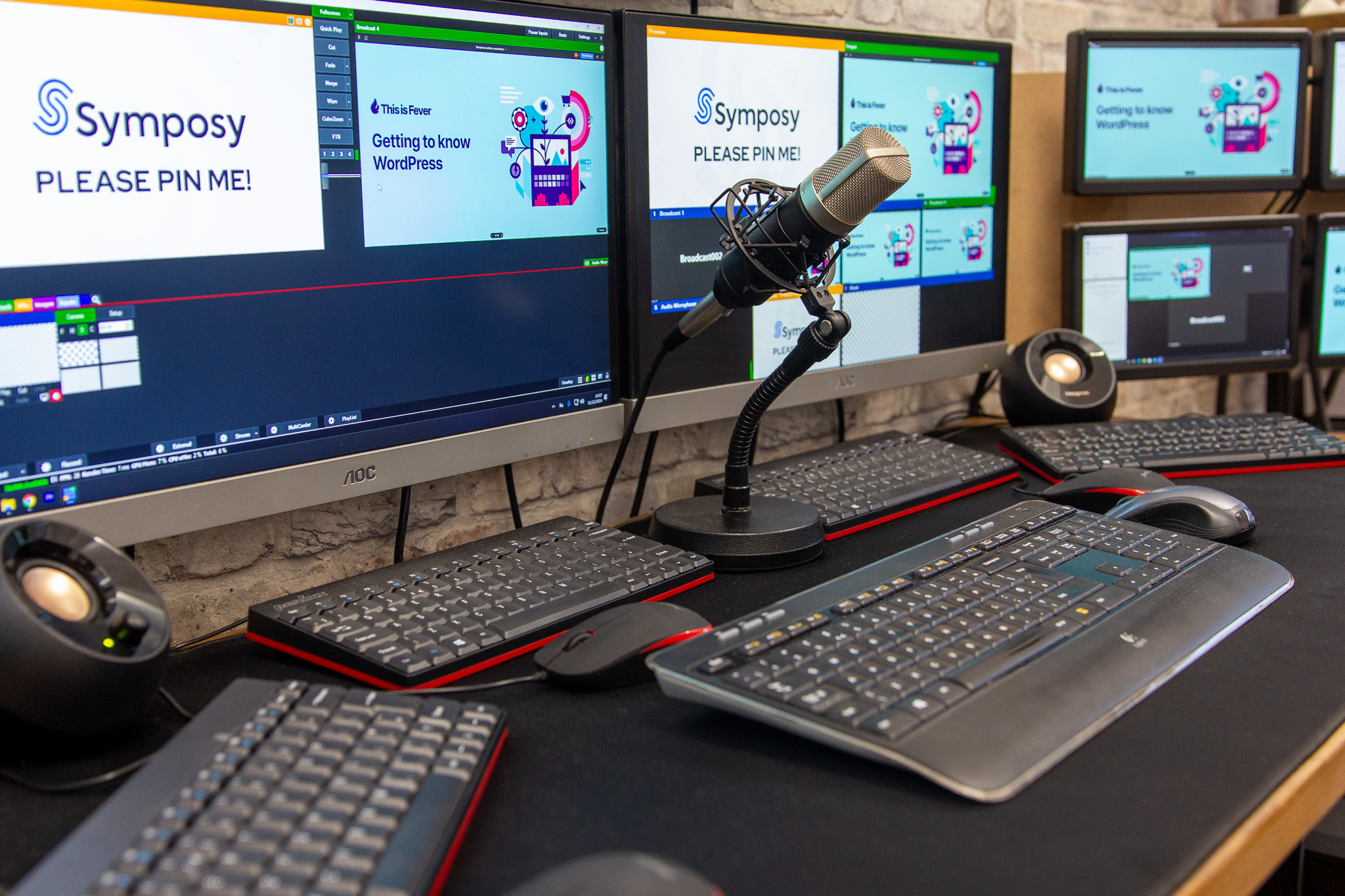A Guide to Virtual and Hybrid Events

In an increasingly digital world, the ways in which we conduct business are constantly evolving to adapt with the times. This goes for events too. In-person events have their place, but, as the world moves forward and we’re faced with a wider variety of options for how we can present our events, why not try something a little different?
The benefits of virtual events, and working remotely in general, were highlighted by the COVID-19 pandemic, and have remained prevalent since. Furthermore, since the end of the lockdown restrictions, there has been a rise in hybrid events, taking the best parts of in-person and virtual events to reap the greatest possible return on investment. This article is a guide to virtual and hybrid events, covering their benefits, what must be considered when utilising them, and how This is Fever can help you to make the most of your events.
What are the benefits of virtual and hybrid events?
Accessibility
Virtual and hybrid events can be seen to be more accessible than their in-person counterparts, due to the avoidance of physical barriers to entry. These barriers could either be physical inaccessibility, which would limit access to individuals with disabilities, or geographical restrictions. Without the need to attend in person, those who are a long distance from the events – in a different country, for example – can still attend, as can those with physical disabilities. For other information on this topic, feel free to check out our article on the Web Content Accessibility Guidelines (WCAG) 2.0.
Cost
These types of events can also be incredibly cost-effective. This is because the expenses for the venue, travel, accommodation, and catering are all reduced or eliminated, depending on whether the event is hybrid or fully virtual. Either way, there are vastly different prices between hosting a fully in-person event, and one that has the load lightened by hosting some of the participants online. However, the cost reduction doesn’t only go for the price – by reducing the amount of travel and the quantity of resources consumed, virtual and hybrid events are of a lower cost environmentally as well.
Scalability and flexibility
In-person events can be quite limiting when it comes to trying to scale them up or down, as well as in any situations where changes need to be made – especially at short notice. Due to the nature of virtual and hybrid events, they are easy to scale in either direction, and can be made to accommodate a vast number of people because they are not limited by venue size. If you were to deal only with in-person events, then you wouldn’t able to host as many people per event. Additionally, the minimum number of attendees needed to make it economically viable is much higher, meaning that you cannot justify smaller events.
As far as flexibility is concerned, virtual and hybrid events provide the option to produce recordings of the event on demand, allowing you to extend the functionality of the event by turning it into content that can be shared at a later date. They also mean that you can make changes right up until the last minute, which is essential when dealing with live events. With an in-person event, a speaker cancelling at the last minute can be devastating, but virtual and hybrid events have the in-built flexibility that could potentially allow you to rearrange the agenda, or even find a new speaker to fill the gap.
Data and analytics
Virtual and hybrid events have great potential when it comes to generating data and analytics from your events. In-person events make it difficult to track much more than the number of people who said that they would attend, without conducting a head count and practically interviewing attendees. However, virtual and hybrid events are a different story. You can track the number of actual attendees, as well as their participation in the various sections of the events. It is far easier to conduct polls, surveys and Q&A sessions, as well as know who is showing interest in certain topics. Additionally, feedback can be collected instantly, and shape further discussion within the event, ensuring that your attendees are getting what they want out of your events.
What are some considerations that have to be made when hosting virtual and hybrid events?
Technology and platform choice
When hosting virtual and hybrid events, it is important to consider the technology that you will be using, and ensure that it is up to scratch. You must have a reliable internet connection, high-quality audio and video, and a robust platform that can support the number of participants that you are expecting to have. The platform should have the features that you might need, such as screen sharing and breakout rooms, as well as an option to record the event. Some examples of platforms that are widely used are Microsoft Teams and Zoom, though I’m sure that everyone remembers them from working through the lockdowns. It is also greatly recommended to have technical support on standby, in case any unforeseen issues occur.
Content delivery and rehearsals
Your speakers must be able to present effectively in a virtual setting. This means that they should be comfortable with the technology that they will have to use. This is very important as any technical delays or confusion could reflect badly on both the speaker and on you. However, a quick and easy way to avoid this is to conduct practice runs prior to the real event. That way, your speaker will be ready to hit the ground running on the day. It also gives you an opportunity to test your equipment and connection – something that should also be checked on the day, before the event goes live.
Audience engagement and interaction
It is a possibility that audience engagement could be more difficult to achieve with virtual and hybrid events, but this can be rectified. These types of events offer you features that you would find much harder to implement in an in-person event, and they can more than make up for the differences in initial engagement. These include things like Q&A sessions or polls.
Although Q&As can be conducted when you host an in-person event, they are more difficult to manage and attendees could feel overlooked if their question is not answered. With virtual and hybrid events however, the questions can be uploaded into a chat feature, and the speaker can select the more frequently asked questions, ensuring maximum attendee satisfaction.
Polls can be very useful for boosting audience interaction, as they provide opportunities for attendees to become a part of the event by contributing their views. Additionally, other opportunities for attendees to share their thoughts, such as panel discussions and workshops, can increase interaction.
Registrations and reminders
When you are looking to generate registrations for virtual and hybrid events, it is important to make sure that you are making use of an event management platform that is suited to your needs – examples of these include Eventbrite or Cvent. These platforms can function well, but require you to do a lot of the work. Therefore, it might be better to utilise a platform that takes a more hands-on approach, like Symposy, This is Fever’s in house events platform (but more on that later).
You should also ensure that your advertising comes from a range of sources, e.g. different social media platforms and email marketing. To improve attendance, it is best to send reminders to attendees prior to the event, to make it as easy as possible for them to remember when your event is.
Additional points to consider
The follow-up process after virtual and hybrid events is very important. It is key to make sure that attendees are engaged with post-event, potentially through emails that could be used to thank them for attending, surveys to collect feedback on the event, and an attachment of the recording for them to review in their own time. It is also a good idea to analyse the feedback that you receive, as well as the data that you have collected over the course of the event, in order to inform the decision-making process for future events.
A final consideration is that scheduling needs to take into account different time zones, in the case of a globally attended event. Events should be hosted at a time suitable for as many attendees as possible, and any who will be unable to attend should be provided with a recording of the event, so that they can still benefit from the content.
How can ‘This is Fever’ help with virtual and hybrid events?
Strategy and technology
This is Fever can work with you to create an event strategy that is tailored to your needs, bringing creative ideas forward to ensure that your event is engaging for your target audience. They will choose the most suitable platform for you to host your event on. This could be a staple such as Zoom or Microsoft Teams, or a bespoke solution like their in-house events platform, Symposy, which was purpose-built for scalability and flexibility, making it the ultimate platform for any company looking for peace of mind when hosting virtual and hybrid events.
The team at Fever will ensure that all technical aspects of your event are integrated together seamlessly, including interactive tools, video streaming and registration systems. They will also be available to provide expert support before, during and after your event so that they can nullify any potential issues that may arise before they become problematic. Additionally, they will coordinate your event to ensure that everything goes according to plan.
Content, branding and promotion
Fever can manage both live and pre-recorded content, allowing your schedule to be more flexible. Also, they can produce content to a high-quality, ranging from presentations to bespoke graphics and animations, all of which make your event more engaging and visually appealing. All of these visual elements will be created with your brand identity in mind, to ensure consistent branding.
The Fever team will also manage the carefully targeted digital marketing effort behind your event. This includes SEO, email campaigns, and social media marketing, the combination of which will provide you with the maximum level of visibility and boost your attendance.
User experience and engagement
The interfaces that This is Fever design for event websites and platforms are user-friendly, meaning that your attendees will find it easy to navigate your event, and interact where required. Accessibility is prioritised throughout, ensuring that all attendees will be able to fully appreciate the event, including anyone who is impacted by a disability. Interactive features like polls, Q&A sessions, and breakout rooms can be integrated into your event by the Fever team, in order to promote engagement and facilitate interaction between attendees.
Post-event activities
The team at This is Fever will set up analytics tools so that you have access to real-time tracking of attendance, engagement, and other key metrics. In addition to this, they will provide you with insightful reports in order to inform you on the successfulness of your event, and how to make the next one even more impactful. Post-event, Fever will help you to follow up with your attendees through surveys and emails, in order to gain further insights. They will also manage the distribution of content such as the event recording in order to further its reach.
Putting it into practice
It’s all well and good telling you what This is Fever can do for your virtual and hybrid events, but how do you know that we can put it into practice? Well, a couple of key examples of hybrid events executed by the Fever team are explained in depth in our McKinsey & Company and OBN case studies. Feel free to explore the case studies in full, but here’s a brief synopsis of what we did for OBN…
The team collaborated with OBN in order to deliver the BioTrinity 2021 conference. Due to the timing of the event being the week after lockdown restrictions were lifted, the organisers wanted to provide a hybrid experience, so that everyone attending could feel comfortable. Utilising Symposy, Fever were able to supply on-demand content, live-streaming, a virtual exhibition environment, a remote Q&A, and peer-to-peer networking. Over half of the 120 presenters did so virtually, and the event attracted more than 400 users, ensuring high levels of engagement, despite the doubts caused by the pandemic.
If you are interested in finding out more about how This is Fever can help you with virtual or hybrid events, or if there’s a design or development topic that you have questions about, then don’t hesitate to get in touch




